
By clicking on the different demographics, you can see a summary of the type of person Esri's geographic data says you are if you live in Harlem.
For Harlem, 55% are coded as "Trendsetters" — educated singles, who "want to stay that way," with incomes big enough to pay for upscale city living and hobbies that include "dining out" and "exploring different hobbies." (Who knew eating was considered a hobby?)
Thirty percent are classified as "City Strivers," people who are "relatively young, foreign-born" with most of their income going to rent. And just over 15% are described as "High Rise Renters" who commute far for work and "struggle to make ends meet."

High population density is common in urban areas and cities and can usually be a good indication for prospective businesses hoping to set up shop.

The median income for Harlem is just over $44,000 — a metric that can be helpful in understanding what a person does and the level of education they've attained.

The median age for this New York ZIP code is 36 — compared to Midtown's median age of 46 years old, there's a significant amount of younger people living in the uptown neighborhood than closer downtown.

At nearly 48%, the number of Upper West Side residents with graduate or professional degrees is more than double the state average.

Advertisers and business owners can use this type of data to better understand the viewership behavior of people who live in certain areas. They can then develop different types of offerings, like sports merchandise or targeted ads.
Esri also lets you look up monthly credit card charges per ZIP code or whether your neighborhood has a high percentage of "Financial Optimists" — people who plan to be better off than they are now in 12 months.
To look up your own ZIP code, head to Esri's website.
 Indian markets conduct disaster recovery test amid improved sentiment and positive FIIs
Indian markets conduct disaster recovery test amid improved sentiment and positive FIIs
 Spiti Valley guide 2024: Stunning locations & interesting things to do
Spiti Valley guide 2024: Stunning locations & interesting things to do
 Zydus Q4 net profit surges 4-fold to ₹1,182 cr; revenue at ₹5,534 cr
Zydus Q4 net profit surges 4-fold to ₹1,182 cr; revenue at ₹5,534 cr

Copyright © 2024. Times Internet Limited. All rights reserved.For reprint rights. Times Syndication Service.